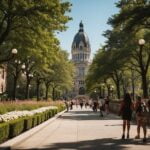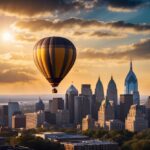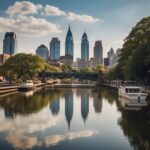Center City Philadelphia is a remarkable blend of history, culture, and urban living. The heart of Philadelphia, this area is both the city’s bustling business district and a neighborhood filled with residential high-rises, historic sites, and cultural institutions. From the iconic Liberty Bell to the lush greenery of Rittenhouse Square, Center City is a microcosm of what makes the City of Brotherly Love so unique.
This comprehensive guide takes a deep dive into the intricacies of Center City Philadelphia, exploring its distinct neighborhoods, tracing its historical origins, examining its diverse population, and highlighting its notable features.
Neighborhoods
Center City Philadelphia is a rich tapestry of diverse neighborhoods, each adding its unique character to the fabric of the city. Within this urban landscape, one can find everything from bustling commercial districts and historic landmarks to quiet, residential corners and cultural hotspots. Each neighborhood reflects a piece of Philadelphia’s story, creating a vibrant and dynamic urban landscape that continues to evolve. Let’s delve into these diverse neighborhoods, exploring the nuances and facets that make each of them unique.
Avenue of the Arts
Envisioned as the epicenter of Philadelphia’s cultural scene, the Avenue of the Arts stretches along Broad Street from Washington Avenue on the south to Glenwood Avenue on the north. Brimming with grandiose theaters, art galleries, and concert halls, the neighborhood is a living, breathing celebration of creativity. The Kimmel Center for the Performing Arts, home to the renowned Philadelphia Orchestra, and the historic Academy of Music are prominent landmarks here. The Avenue is also a hub for educational institutions, with the University of the Arts and the Pennsylvania Academy of Fine Arts fostering the city’s creative talents.
The Avenue of the Arts isn’t just about culture and education, though. It’s also a vibrant residential and commercial district. The neighborhood’s northern section boasts skyscrapers housing businesses and luxury condos, while the southern end is home to an array of high-end restaurants and boutique shops. The Avenue truly represents Philadelphia’s dynamic blend of arts, culture, and cosmopolitan living.
Finally, the Avenue of the Arts stands as an example of successful urban renewal. Its transformation from a declining commercial corridor in the 1980s into today’s thriving cultural district is a testament to the city’s commitment to arts and culture as catalysts for urban revitalization.
Callowhill
Callowhill, with its industrial charm and rising urban appeal, offers a distinct narrative within the Center City tapestry. Often referred to as the ‘Loft District’, Callowhill has a raw, unpolished aesthetic that speaks to its history as a former manufacturing district. Here, historic factories and warehouses have been transformed into modern lofts, studios, and commercial spaces, all while retaining their original architectural character.
Despite its industrial feel, Callowhill isn’t devoid of green spaces. The neighborhood boasts the elevated Rail Park, Philadelphia’s answer to New York City’s High Line, which offers residents and visitors an urban oasis with impressive city views. This fusion of old and new, green and industrial, gives Callowhill a unique charm that’s increasingly drawing Philadelphians to the neighborhood.
Callowhill’s resurgence isn’t just about converting old spaces into new ones. It’s also about creating a vibrant community around these spaces. Today, the neighborhood is home to a thriving arts scene, with music venues, galleries, and performance spaces adding a creative energy to the district. Callowhill stands as a testament to Philadelphia’s capacity for reinvention, preserving its past while boldly stepping into the future.
Chinatown
Chinatown is a vibrant enclave of Asian culture in the heart of Philadelphia. Its colorful streets, lined with traditional Asian restaurants, bakeries, grocery stores, and small businesses, offer a unique cultural experience. The Chinatown Friendship Gate, an intricately designed Chinese arch at 10th and Arch Streets, is a well-known landmark that welcomes visitors to the neighborhood.
Yet, Chinatown isn’t just a cultural hotspot; it’s also a thriving residential community. Over the years, it has been home to successive waves of immigrants who have contributed to the neighborhood’s rich cultural tapestry. High-rise apartments and family homes line the streets, interspersed with community centers and schools.
Chinatown’s story is also one of resilience. Over the years, the neighborhood has faced numerous threats from urban development projects, yet each time, the community has rallied to protect and preserve its cultural identity. Today, Chinatown continues to evolve, its streets telling stories of community, resilience, and the ongoing journey of its immigrant population.
Elfreth’s Alley
Elfreth’s Alley, a street in Old City Philadelphia, is recognized as the nation’s oldest continuously inhabited residential street. Dating back to the first half of the 18th century, it represents over 300 years of Philadelphia’s history. Walking down the cobblestone street feels like stepping back in time, with 32 houses on the street listed on the National Register of Historic Places.
Despite the passage of centuries, the community spirit in Elfreth’s Alley remains strong. Every year, the Elfreth’s Alley Association hosts “Deck the Alley,” an annual holiday event where residents open their homes to the public. This allows visitors a rare glimpse into life within these historic homes, while the “Fete Day” in June celebrates the diverse heritage of the alley’s inhabitants over the centuries.
Interestingly, Elfreth’s Alley isn’t a static piece of history. It is a living, breathing entity with residents who contribute to its ongoing story. The alley embodies the essence of historic Philadelphia, reminding locals and visitors alike of the city’s rich, layered history while also representing an enduring residential tradition.
French Quarter
Located within the Center City, the French Quarter reflects the rich Franco-American heritage of Philadelphia. This neighborhood, with its boutique hotels, bistros, bakeries, and shops, offers a distinctly European ambiance. The French influence is palpable in the architectural styles of the buildings, the food, and the occasional French language signages.
The French Quarter also hosts a vibrant arts scene. Art galleries showcasing works from local and international artists, music festivals, and live performances lend a creative flair to the neighborhood. A number of Francophile cultural and educational institutions are also based here, promoting Franco-American friendship and understanding.
Finally, the French Quarter is a hub for gastronomical delights. From authentic French cuisine to fusion food that combines French culinary techniques with Philadelphia’s local flavors, the dining scene here is diverse and delightful. It’s this blend of culture, art, and food that gives the French Quarter its unique charm within Center City.
Logan Square
Logan Square, located in the northwest quadrant of Center City, is an iconic Philadelphia neighborhood. It is recognized for its unique blend of history, culture, and modernity. Dominated by the Swann Memorial Fountain, one of the city’s most recognizable landmarks, Logan Square embodies Philadelphia’s spirit in a picturesque setting.
Named after James Logan, an 18th-century mayor of Philadelphia, Logan Square was once a fashionable residential district. Over time, it has evolved into a bustling hub of museums, educational institutions, and commercial towers. The neighborhood is home to the Franklin Institute, the Free Library of Philadelphia, the Academy of Natural Sciences, and the Barnes Foundation, making it a cornerstone of Philadelphia’s intellectual and cultural life.
Adding to its vibrant character, Logan Square is the gateway to the Benjamin Franklin Parkway, often compared to the Champs-Élysées in Paris. This grand boulevard is the site of the city’s most significant civic celebrations and large-scale events. The blend of verdant park spaces, ornate architecture, and cultural institutions gives Logan Square a distinctive charm and vibrant character that is uniquely its own.
Naval Square
Naval Square is a historic gated community nestled in the heart of Center City. Originally the site of the Philadelphia Naval Asylum, a hospital and retirement home for naval officers, the area was transformed into a residential community in the early 21st century while retaining many of its historic features.
The centerpiece of Naval Square is the Biddle Hall, a Greek Revival structure designed by William Strickland, a noted 19th-century architect. The building, listed on the National Register of Historic Places, now serves as the community’s clubhouse. It stands as a symbol of the rich history embedded within the fabric of this unique neighborhood.
Today, Naval Square is known for its mix of modern townhouses and historic buildings, its well-kept green spaces, and its strong sense of community. Its central location, close to both the University City and Rittenhouse Square, makes it a desirable living location. The blend of history, community, and urban convenience lends Naval Square a unique charm within the landscape of Philadelphia’s Center City.
Jeweler’s Row
Jewelers’ Row, situated in Center City, is America’s oldest diamond district and the second largest in the country, surpassed only by New York City. Established in the 19th century, the neighborhood spans the 700 block of Sansom Street and the 700 block of Eighth Street. Its storied history and enduring presence make it a notable feature of Philadelphia’s urban fabric.
The district’s rich architectural history is evident in the row houses dating back to the early 19th century, with many buildings reflecting the Federal architectural style. These structures were initially residential, but by the mid-19th century, they began to serve as workshops and stores for the area’s burgeoning jewelry industry. Today, over 300 diamond merchants, goldsmiths, gem dealers, and jewelry artisans call this district home, preserving its reputation as a sparkling destination for high-quality jewelry craftsmanship.
Besides the historic value, Jewelers’ Row is a destination for those seeking high-quality craftsmanship. With countless family-owned businesses passed down through generations, it’s a testament to the enduring artisan spirit that defines Philadelphia. The neighborhood’s unique blend of rich history, architectural beauty, and creative commerce contribute to the irreplaceable character of Center City.
Market East
Market East, located in the heart of Center City, is a vibrant neighborhood that mixes retail, entertainment, and residential areas. The neighborhood is centered around Market Street, a major thoroughfare in Philadelphia, providing easy access to numerous city attractions.
This district boasts the Reading Terminal Market, one of America’s largest and oldest public markets. Since its opening in 1893, the market has consistently offered a wide variety of locally sourced food and products. Moreover, the Pennsylvania Convention Center, a multi-purpose venue for events, is another key feature of Market East, bringing a dynamic energy to the neighborhood.
Market East has undergone significant transformation over the years. It has seen a recent resurgence with the opening of the Fashion District Philadelphia, a retail and entertainment complex, which has brought an influx of new businesses and residents to the area. The neighborhood now features a growing number of high-rise apartments, expanding its residential offerings. With its lively mix of shopping, dining, and cultural attractions, Market East has secured its spot as a prominent neighborhood in Center City.
Old City
Old City, often referred to as America’s most historic square mile, is a neighborhood that boasts deep historical roots and an innovative spirit. As the birthplace of the nation, it holds a special place in the heart of Philadelphians and visitors alike, offering a profound connection to the past.
The neighborhood is brimming with iconic sites that tell the tale of early America. The Independence National Historical Park, home to the Liberty Bell and Independence Hall, where the Declaration of Independence and Constitution were signed, are must-visit locations within Old City. Moreover, Elfreth’s Alley, the nation’s oldest residential street, is a time-capsule-like glimpse into the colonial-era architecture.
Despite its ancient roots, Old City isn’t stuck in the past. The neighborhood is a thriving spot for arts, culture, and nightlife. First Friday, a monthly event where galleries open their doors for the evening, has become a city-wide draw, celebrating the area’s vibrant arts scene. The combination of history and hip urban lifestyle has crafted Old City into a vibrant neighborhood with an enduring appeal.
Museum District
The Museum District, also known as the Parkway Museums District, is a cultural powerhouse neighborhood in Center City. Located along Benjamin Franklin Parkway, the neighborhood is named for its high concentration of cultural institutions, including some of Philadelphia’s most esteemed museums.
At the heart of the district is the Philadelphia Museum of Art, known worldwide for its vast collections spanning many centuries and cultures. It is also home to the Rodin Museum, which boasts the largest collection of works by Auguste Rodin outside Paris. The Barnes Foundation, with its impressive collection of Impressionist and Post-Impressionist art, adds to the neighborhood’s rich cultural offering.
Beyond museums, the district is known for its grand Beaux-Arts buildings and open urban spaces, including the picturesque Logan Square and Fairmount Park. With cultural institutions, stunning architecture, and plenty of green space, the Museum District is a beacon for art lovers and an emblem of Philadelphia’s cultural richness.
Penn Center
Penn Center, located in the heart of Center City, is a dynamic business district that plays a vital role in Philadelphia’s economic landscape. The district, named after Pennsylvania’s founder William Penn, has served as a transportation hub since the 19th century and has grown into a significant commercial sector.
The district’s name also stems from the former Pennsylvania Railroad’s broad street station that once stood here. Today, the area is filled with high-rise office buildings, including some of the city’s tallest structures, such as the Comcast Center. These skyscrapers house numerous corporate headquarters and an assortment of businesses, contributing to the city’s robust economy.
Penn Center is also home to LOVE Park, a well-known public space characterized by Robert Indiana’s iconic “LOVE” sculpture. This urban park offers a breath of fresh air amidst the bustling cityscape. From the commanding skyscrapers to the vibrant public spaces, Penn Center is a testimony to Philadelphia’s evolution as a thriving metropolis.
Rittenhouse Square
Rittenhouse Square is a prestigious and upscale neighborhood in Center City. Named after the park at its heart, it’s a neighborhood that blends the serenity of green spaces with the vibrancy of urban life, offering a distinct charm that draws residents and visitors alike.
Regarded as one of the finest urban public spaces in the United States, Rittenhouse Square Park is a tree-lined park, popular for picnicking, walking, and enjoying the outdoors. Surrounding the park, you’ll find stately townhouses, luxury high-rises, and some of Philadelphia’s best-known restaurants, bars, and shops.
The neighborhood also boasts a rich cultural scene with galleries, theaters, and music venues, including the Curtis Institute of Music, one of the world’s leading conservatories. With its blend of green space, architectural beauty, and thriving cultural and culinary scene, Rittenhouse Square is a gem in the heart of Philadelphia.
Fitler Square
Nestled in the southwestern part of Center City, Fitler Square is a charming and tranquil neighborhood known for its scenic beauty, residential character, and namesake public park. The area’s peaceful, tree-lined streets and 19th-century homes create a serene and picturesque setting that contrasts with the bustle of larger Center City.
Fitler Square Park, with its Victorian-era fountain, sculptures, and well-maintained flower beds, is the heart of this neighborhood. Regular farmers’ markets in the park add a sense of community spirit and provide a place for locals to mingle and shop for local produce.
Along with the peaceful residential area and park, Fitler Square is within walking distance of the Schuylkill River Park and the bustling Rittenhouse Square, providing a perfect balance of calm and convenience. Fitler Square’s blend of quiet charm and accessibility makes it one of Center City’s most desirable neighborhoods.
Penn’s Landing
Penn’s Landing, named for William Penn’s 1682 landing in Philadelphia, is the city’s waterfront neighborhood along the Delaware River. With a fantastic array of attractions, recreational amenities, and year-round events, it’s a neighborhood where history, culture, and fun meet.
The area is the host of the historic ship Gazela, the Seaport Museum, and the submarine USS Becuna. These maritime attractions offer a unique way to delve into Philadelphia’s nautical history. Additionally, the neighborhood boasts an outdoor seasonal ice-skating rink and a summer concert venue, making it a year-round attraction.
Not just for recreation, Penn’s Landing also offers stunning views of the Delaware River and the Benjamin Franklin Bridge. With its numerous attractions and stunning waterfront setting, Penn’s Landing remains a central part of Philadelphia’s rich tapestry.
South Street
South Street is a vibrant neighborhood in Center City known for its eclectic mix of boutiques, eateries, bars, and entertainment venues. Straddling the border between Center City and South Philadelphia, it serves as a melting pot of cultures, adding to the city’s diverse appeal.
The South Street corridor, particularly the area known as South Street Headhouse District, is a hub of activity, offering a diverse mix of shops, restaurants, and nightlife. From vintage clothing stores to tattoo parlors, to music shops and art galleries, there’s always something to discover on South Street.
Moreover, South Street is also home to the Magic Gardens, an immersive mixed-art environment that is completely covered with mosaics. The neighborhood’s vibrant street life, unique shopping, and dining options, and creative pulse make South Street a must-visit destination in Center City.
Washington Square West
Washington Square West, a neighborhood that surrounds Washington Square Park, one of William Penn’s original five squares, is steeped in history while also embracing modern city life. A blend of residential areas, businesses, and green spaces make this neighborhood a diverse and vibrant part of Center City.
In the heart of the neighborhood, Washington Square Park is a leafy retreat that invites relaxation and reflection. The park is also home to the Tomb of the Unknown Soldier of the American Revolution, adding a historical dimension to this tranquil space.
Washington Square West also includes the Gayborhood, recognized for its vibrant LGBT culture and rainbow street signs. The neighborhood’s welcoming atmosphere, historic charm, and lively dining and nightlife scene make Washington Square West a unique and exciting part of Center City.
Penn’s Landing
Penn’s Landing, a waterfront area located along the Delaware River, is one of the most scenic spots in Center City. It is named after William Penn, who docked near this site when he first arrived in the city. Penn’s Landing is now known for its historic ships, open parks, and events throughout the year.
The Great Plaza at Penn’s Landing is a popular location for outdoor concerts and festivals, featuring a stunning backdrop of the Benjamin Franklin Bridge. Also in the area, you’ll find the Independence Seaport Museum, where you can explore the maritime history of the Delaware River.
In addition to the historic ships open for touring, like the USS Olympia and the USS Becuna, Penn’s Landing also features a seasonal ice skating rink and a summer Spruce Street Harbor Park, an urban beach with a boardwalk, beer garden, and floating restaurant. The area’s picturesque views and plethora of activities make it a prime location for visitors and locals alike.
Fitler Square
Fitler Square is a small, charming neighborhood nestled within Center City, Philadelphia. Known for its leafy streets, family-friendly atmosphere, and beautiful Victorian-style homes, this neighborhood is centered around the eponymous Fitler Square Park.
The neighborhood features a range of restaurants, cafes, and boutique shops, as well as easy access to the Schuylkill River Trail. This popular walking and biking path offers stunning views of the river and the city’s skyline, enhancing the appeal of living in or visiting this area.
Fitler Square’s serene, residential character, combined with its close proximity to Center City’s bustle, make it a desirable location. It offers a quiet retreat in the heart of the city, ideal for those looking for the charm of a small community within a larger urban context.
South Street
South Street is one of Philadelphia’s most eclectic and energetic neighborhoods. It is known for its diversity, creative spirit, and vibrant nightlife. South Street is the city’s hipster hub, offering an array of quirky shops, diverse eateries, and vibrant entertainment venues, making it a favorite among both locals and visitors.
The street is home to landmarks like the Theatre of the Living Arts, a venue that hosts concerts and live performances, and the Magic Gardens, a unique mosaic art environment created by Isaiah Zagar. The latter is an immersive, multi-level outdoor art installation that stretches for half a block.
South Street’s energetic vibe, with its blend of arts, music, and culinary delights, is what makes it an integral part of Center City. Whether it’s savoring a Philly cheesesteak, exploring indie boutiques, or enjoying live music, there’s something for everyone here.
Washington Square West
Washington Square West is a historic Philadelphia neighborhood named after one of William Penn’s five original squares. The square itself, known as Washington Square, is a peaceful green space featuring a monument to George Washington and a memorial to unknown soldiers of the American Revolutionary War.
A part of the neighborhood, known as the Gayborhood, is recognized for its vibrant LGBTQ+ community and culture. The area is marked with rainbow street signs, symbolizing its inclusivity. It’s home to many LGBTQ+ friendly businesses and hosts the city’s annual Pride events.
Washington Square West offers a mix of residential areas, businesses, and historic sites, making it a dynamic part of Center City. Its blend of history and contemporary urban life makes it a captivating locale, reflective of Philadelphia’s diverse culture and vibrant history.
History
Center City Philadelphia’s history is essentially the history of the United States. As one of the oldest cities in the nation, Philadelphia was the nation’s first capital and the location of the drafting of the U.S. Constitution. Center City stands as the heart of this history, with structures and streets that still whisper tales from centuries ago.
Center City, originally planned by William Penn, the founder of Pennsylvania, was designed with a grid street plan with five squares of public open space. The area was central to the social, political, and commercial life of the early city. In the 18th century, it was one of the nation’s busiest ports, and in 1774, it hosted the First Continental Congress, leading to the signing of the Declaration of Independence in 1776.
The 19th century saw the construction of City Hall, one of the nation’s largest municipal buildings and the world’s tallest habitable building when completed in 1901. Center City also became a hub for culture and education during this period, with the founding of institutions such as the Pennsylvania Academy of the Fine Arts, the Athenaeum, and the University of Pennsylvania.
In the 20th century, Center City continued to thrive as the core of Philadelphia’s economy. Major construction projects reshaped its skyline, and redevelopment of neighborhoods brought about a residential renaissance. The preservation and restoration of historic sites, such as Independence Hall and Old City, have kept the city’s history alive, even as new developments rise around them.
Today, Center City carries its history proudly, while continually evolving. It retains its original character as a vibrant blend of commercial, cultural, and residential life. Its rich history shapes its identity, making it not just the geographic heart of Philadelphia, but its cultural and historical heart as well.
Demographics
Center City Philadelphia is a dynamic and diverse area that showcases the broad range of backgrounds and lifestyles found within the city. As of the latest census data, the population of Center City is a vibrant mix of age groups, ethnicities, and income levels.
The area is known for its diverse population, encompassing both long-term residents with deep roots in the city and newer residents drawn by the area’s energy and opportunity. The area’s population is relatively young, with a significant portion in their 20s and 30s, a demographic that reflects the presence of several major universities and businesses in and around Center City.
The racial and ethnic makeup of Center City is also diverse, featuring a mix of White, African American, Asian, and Hispanic residents, among other ethnicities. This cultural mosaic is reflected in the variety of restaurants, shops, and cultural festivals that can be found throughout the area.
Income levels within Center City vary considerably, with a mix of high-income professionals, middle-income workers, and lower-income residents. This economic diversity is a key characteristic of Center City and contributes to its rich variety of housing, from luxury apartments and historic townhouses to affordable housing units.
The diversity of Center City extends to its family structures as well. The area is home to a variety of household types, including families, single professionals, and shared households. A large number of residents live alone, reflecting the area’s appeal to both young professionals and older adults.
This vibrant demographic mix contributes to Center City’s dynamism and liveliness, making it a microcosm of Philadelphia’s broader diversity. The area’s demographic characteristics continue to evolve, further enhancing its position as a key cultural and economic hub in the city.
Notable Features
Center City, as the heart of Philadelphia, boasts an array of notable features that contribute to its distinctive character and allure. It is home to several iconic landmarks and cultural institutions that draw both residents and visitors alike.
One of the most recognizable features of Center City is City Hall, the largest municipal building in the United States. Constructed in the Second Empire style, it’s topped with a statue of city founder William Penn, and the observation deck beneath it offers panoramic views of the city.
Moreover, Center City is renowned for its diverse architectural styles. Along with historical buildings, such as the Liberty Bell Center and Independence Hall in the Old City, the area is also home to modern architectural wonders like the Comcast Center, Philadelphia’s tallest skyscraper. The distinctive styles of these buildings create a unique skyline that is instantly recognizable.
Another notable feature of Center City is its green spaces. Rittenhouse Square and Logan Square are two prominent examples, providing residents with urban oases for recreation and relaxation. These squares are part of the original city plan by William Penn and contribute to the area’s charm and livability.
Center City also boasts a bustling arts scene, highlighted by the Avenue of the Arts. This vibrant stretch along South Broad Street is home to numerous theaters, galleries, and performance venues, including the Kimmel Center for the Performing Arts and the Academy of Music.
The Reading Terminal Market, another prominent feature, is one of the country’s oldest continuously operating farmers’ markets. A food lover’s paradise, it offers a vast selection of locally produced and international foods.
Lastly, the Delaware River Waterfront, encompassing Penn’s Landing, offers a host of attractions, parks, and festivals, providing a recreational hub for residents and visitors alike.
Center City, with its distinctive blend of history, culture, and urban vibrancy, provides an array of notable features that make it a unique and appealing destination within Philadelphia.
Conclusion
Center City Philadelphia serves as the heart and soul of the City of Brotherly Love, embodying the city’s rich history, cultural diversity, and vibrant urban life. It’s a fascinating mosaic of distinct neighborhoods, each with its own character, history, and charm. From the historic charm of Elfreth’s Alley to the modern high-rises of Penn Center, from the cultural richness of Chinatown to the artistic vibrancy of Avenue of the Arts, Center City encapsulates the spirit of Philadelphia in a unique and captivating way.
While it stands as a hub of commerce and government, it’s also a place where people live, work, and play. The area’s green spaces, like Rittenhouse Square and Logan Square, provide an urban oasis, while its thriving arts scene, diverse culinary offerings, and lively neighborhoods make it a desirable place to live and a must-see for visitors.
This guide provides just a glimpse of what makes Center City a remarkable part of Philadelphia. For an even more comprehensive look at this city’s unique blend of history, culture, and modern amenities, don’t miss our extensive guide, “Discovering Philadelphia: A Comprehensive Guide to the City of Brotherly Love.” This expansive resource offers deeper insights into the distinctive neighborhoods, attractions, and features that make Philadelphia a city like no other.







2 thoughts on “Center City Philadelphia: A Gem in the Heart of the City of Brotherly Love”